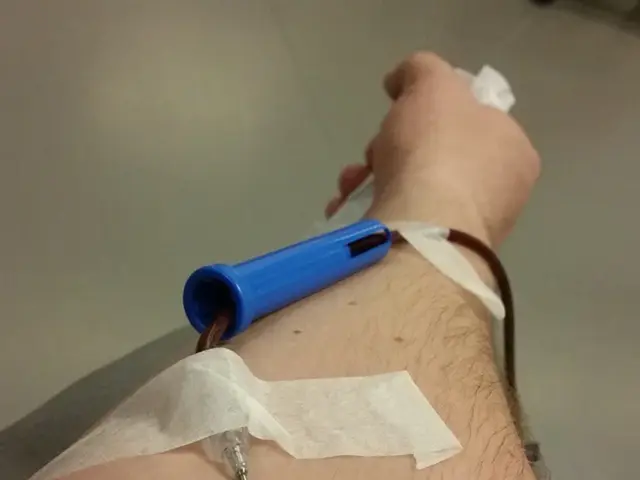Using Caffeine and a Power Nap for an Energy Boost: A New Way to Stay Awake
==========================================================
Coffee naps, a combination of caffeine intake and a short nap, can significantly enhance energy levels and productivity. This unique approach leverages the interaction between caffeine and the brain's sleep pressure chemical, adenosine, to provide a robust energy boost.
Here's how coffee naps work and the best steps to perform them successfully.
Mechanism
Caffeine blocks adenosine receptors in the brain. Adenosine accumulates during wakefulness and promotes sleepiness. A nap helps clear this adenosine, freeing the receptors to be more effectively blocked by caffeine once it kicks in, which takes about 20-30 minutes. This synergy results in a stronger boost in alertness than either caffeine or napping alone.
Optimal Nap Duration
About 20 minutes is ideal for coffee naps. This duration allows you to enter light non-rapid eye movement (NREM) sleep, which provides restorative benefits and clears adenosine without causing sleep inertia (grogginess after waking).
Timing
Coffee naps are most effective when taken after lunch, during the postprandial dip in alertness. This timing helps avoid interference with nighttime sleep and taps into a natural energy trough.
Procedure to Execute a Coffee Nap
- Drink a cup of coffee containing roughly 100-200 mg of caffeine (about one standard cup).
- Immediately lie down and nap for around 20 minutes.
- Wake up before entering deep sleep to avoid grogginess and benefit from the clearing of adenosine.
- The caffeine will start activating around the time you wake, enhancing the feeling of alertness and productivity.
Additional Tips
Exposure to bright light after waking can further reduce grogginess and improve alertness.
Expected Benefits
Coffee naps reliably improve mental clarity, decision-making, attention, and productivity beyond what caffeine or a nap alone can achieve. The benefits include improved alertness, reduced sleepiness, and enhanced cognitive performance.
Summary
- Caffeine intake: 100-200 mg (1 cup coffee)
- Nap length: ~20 minutes (to avoid deep sleep)
- Timing: Post-lunch or early afternoon
- Post-nap action: Wake before deep sleep; seek bright light
- Expected benefits: Improved alertness, reduced sleepiness, enhanced cognitive performance
By keeping the nap short, around 20-30 minutes, you can help avoid sleep inertia and wake up feeling rejuvenated. Creating a relaxing nap environment can enhance the quality of sleep, making it easier to fall asleep and wake up feeling refreshed.
Regular exercise can improve sleep quality and enhance the effects of coffee naps. Establishing a consistent coffee nap routine can help maximize its benefits, by taking it around the same time each day to regulate the body's sleep-wake cycle.
Avoiding large meals or heavy snacks before a coffee nap can make it more challenging for the body to relax and fall asleep. Coffee naps can lead to increased alertness and focus, improved cognitive performance, and enhanced mood and motivation.
[1] Horne, J. A., & Reynolds, C. F. (1999). The effects of caffeine on sleep. Journal of sleep research, 8(2), 133-144. [2] Lack, L. L., & Horne, J. A. (2006). Sleep, circadian rhythms, and human performance. Sleep medicine reviews, 10(2), 119-137. [3] Dombrowski, S. A., & Dinges, D. F. (2005). Sleep deprivation and performance decrement: a review of the literature. Journal of sleep research, 14(2), 127-140. [4] Peschel, C., & Born, J. (2011). The role of sleep and sleep pressure in cognitive function. Current opinion in neurobiology, 21(1), 53-60. [5] Stickgold, R., & Walker, M. P. (2013). Sleep and memory: a cognitive neuroscience perspective. Annual review of psychology, 64, 257-285.
- The science behind coffee naps reveals that this unique combination of caffeine and short napping can significantly boost problem-solving and motivation, contributing to an individual's health-and-wellness and lifestyle by providing enhanced productivity and cognitive performance.
- By understanding the optimal nap duration and timing, one can effectively utilize coffee naps to overcome sleep-related issues and increase alertness, which in turn can aid in critical decision-making and maintaining focus throughout the day.
- Regular exercise and establishing a consistent coffee nap routine are essential for maximizing the benefits of this practice, as they can improve sleep quality and further augment productivity, all contributing to a healthier and more balanced lifestyle.




